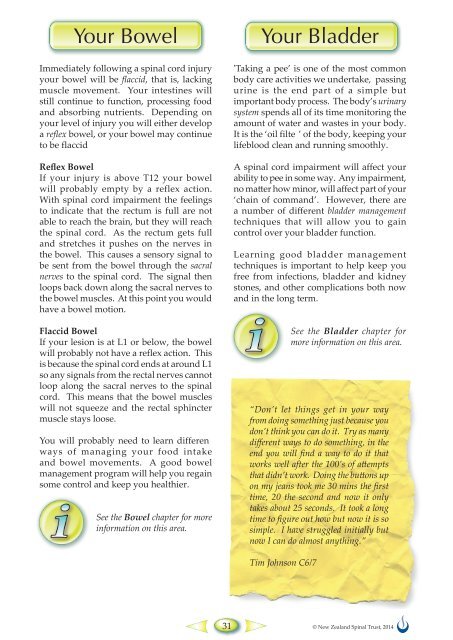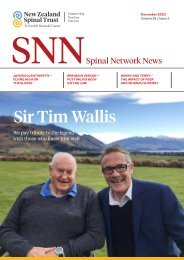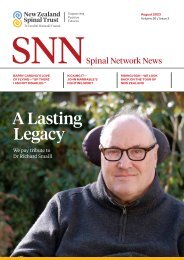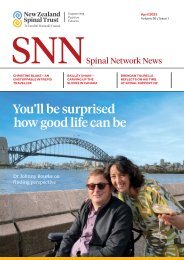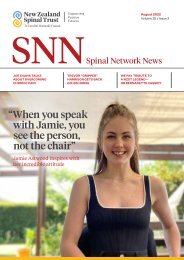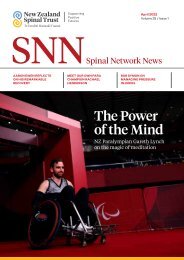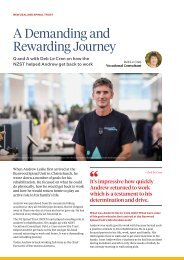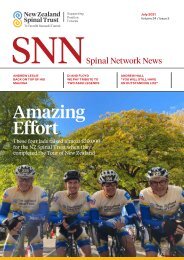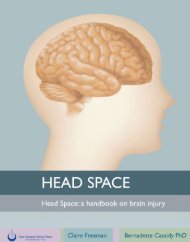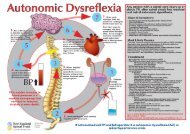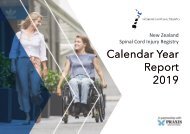Back_on_Track_Promo2016a
You also want an ePaper? Increase the reach of your titles
YUMPU automatically turns print PDFs into web optimized ePapers that Google loves.
Your Bowel<br />
Immediately following a spinal cord injury<br />
your bowel will be flaccid, that is, lacking<br />
muscle movement. Your intestines will<br />
still c<strong>on</strong>tinue to functi<strong>on</strong>, processing food<br />
and absorbing nutrients. Depending <strong>on</strong><br />
your level of injury you will either develop<br />
a reflex bowel, or your bowel may c<strong>on</strong>tinue<br />
to be flaccid<br />
Reflex Bowel<br />
If your injury is above T12 your bowel<br />
will probably empty by a reflex acti<strong>on</strong>.<br />
With spinal cord impairment the feelings<br />
to indicate that the rectum is full are not<br />
able to reach the brain, but they will reach<br />
the spinal cord. As the rectum gets full<br />
and stretches it pushes <strong>on</strong> the nerves in<br />
the bowel. This causes a sensory signal to<br />
be sent from the bowel through the sacral<br />
nerves to the spinal cord. The signal then<br />
loops back down al<strong>on</strong>g the sacral nerves to<br />
the bowel muscles. At this point you would<br />
have a bowel moti<strong>on</strong>.<br />
Flaccid Bowel<br />
If your lesi<strong>on</strong> is at L1 or below, the bowel<br />
will probably not have a reflex acti<strong>on</strong>. This<br />
is because the spinal cord ends at around L1<br />
so any signals from the rectal nerves cannot<br />
loop al<strong>on</strong>g the sacral nerves to the spinal<br />
cord. This means that the bowel muscles<br />
will not squeeze and the rectal sphincter<br />
muscle stays loose.<br />
You will probably need to learn differen<br />
ways of managing your food intake<br />
and bowel movements. A good bowel<br />
management program will help you regain<br />
some c<strong>on</strong>trol and keep you healthier.<br />
See the Bowel chapter for more<br />
informati<strong>on</strong> <strong>on</strong> this area.<br />
Your Bladder<br />
'Taking a pee’ is <strong>on</strong>e of the most comm<strong>on</strong><br />
body care activities we undertake, passing<br />
urine is the end part of a simple but<br />
important body process. The body’s urinary<br />
system spends all of its time m<strong>on</strong>itoring the<br />
amount of water and wastes in your body.<br />
It is the ‘oil filte ’ of the body, keeping your<br />
lifeblood clean and running smoothly.<br />
A spinal cord impairment will affect your<br />
ability to pee in some way. Any impairment,<br />
no matter how minor, will affect part of your<br />
‘chain of command’. However, there are<br />
a number of different bladder management<br />
techniques that will allow you to gain<br />
c<strong>on</strong>trol over your bladder functi<strong>on</strong>.<br />
Learning good bladder management<br />
techniques is important to help keep you<br />
free from infecti<strong>on</strong>s, bladder and kidney<br />
st<strong>on</strong>es, and other complicati<strong>on</strong>s both now<br />
and in the l<strong>on</strong>g term.<br />
See the Bladder chapter for<br />
more informati<strong>on</strong> <strong>on</strong> this area.<br />
“D<strong>on</strong>’t let things get in your way<br />
from doing something just because you<br />
d<strong>on</strong>’t think you can do it. Try as many<br />
different ways to do something, in the<br />
end you will find a way to do it that<br />
works well after the 100’s of attempts<br />
that didn’t work. Doing the butt<strong>on</strong>s up<br />
<strong>on</strong> my jeans took me 30 mins the first<br />
time, 20 the sec<strong>on</strong>d and now it <strong>on</strong>ly<br />
takes about 25 sec<strong>on</strong>ds. It took a l<strong>on</strong>g<br />
time to figure out how but now it is so<br />
simple. I have struggled initially but<br />
now I can do almost anything.”<br />
Tim Johns<strong>on</strong> C6/7<br />
31<br />
© New Zealand Spinal Trust, 2014


